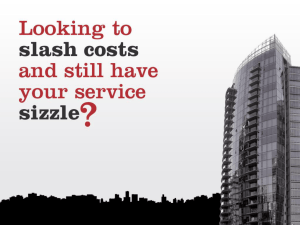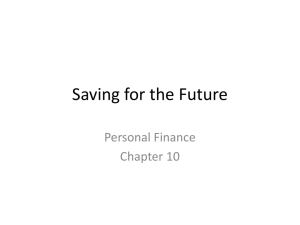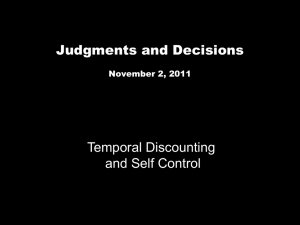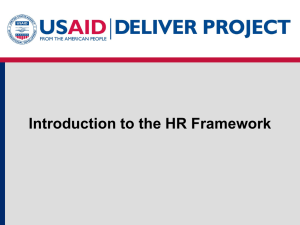Utility-driven Demand Side Management (DSM) under EU Energy
advertisement
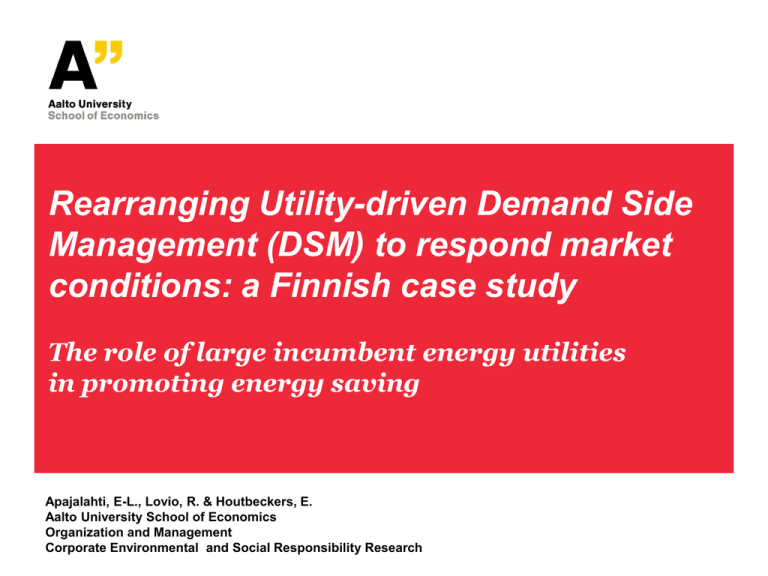
Rearranging Utility-driven Demand Side Management (DSM) to respond market conditions: a Finnish case study The role of large incumbent energy utilities in promoting energy saving Apajalahti, E-L., Lovio, R. & Houtbeckers, E. Aalto University School of Economics Organization and Management Corporate Environmental and Social Responsibility Research “Why would Energy Companies want us to save energy, the very product that it gets profit from?“ Source: NCRC –survey 2009 Why energy efficiency? • Improving energy and electricity end-use efficiency 40-63% of the solution (IEA WEO 2008). 63 % 40 – 50 % • Transition to renewable energy sources is a long process • Energy efficiency improvements may be faster and more costeffective. Eeva-Lotta Apajalahti 10.6.2011 3 Policy obligations on energy utilities • EU Directive (2006/32/EC) on energy end-use efficiency and energy services (ESD) – – – – Indicative national 9 % energy saving target 2008-2016. Minimum requirements on reducing energy end-use of its clients. Directive will be revised (and tighten) in 2013. In Finland implemented through renewed voluntary Energy Efficiency Agreement system, obligate 80 % of energy utilities • National, ESD complimenting law on energy efficiency services, obligate all energy utilities (1211/2009). • Remote reading, billing must be based on verified energy use by 2014. • EU 20-20-20 targets – Obligate energy utilities through different ways e.g. City of Helsinki engagement to carbon neutrality by the 2050. Eeva-Lotta Apajalahti 10.6.2011 4 Energy utility as an energy saving promoter • Role of energy utility... – has been traditionally strong but reduced since market liberalisation. – has been decreasing since new intermediary organisations, energy saving companies (ESCOs) have taken the task (Breukers et al. 2009, Heiskanen et al. 2009, Bertoldi et al. 2006). – is not natural in implementing energy saving (Demand Side Management, DSM) initiatives because it does not gain monetary benefits of doing so (Didden & D’haeseleer 2003). – in developing new energy-efficient products and services in liberalised and privatised energy markets is uncertain (Vine et al. 2003). • Past DSM efforts often led to negative business experiences. – Past experiences and learning outcomes of load shifting and DSM initiatives/programs introduced in 1980-1990 in US. (Strbac 2008, Gehring 2002, Eto 1996, Vine 1996). Eeva-Lotta Apajalahti 10.6.2011 5 Electricity retailers operating environment in Finland • Energy Market Act (1995/1998) – Large energy users (1995) and small energy users (1998). – Unbundling electricity trade operations from other trade operations. – Separating electricity network operations from other business operations. • Operating environment of electricity retailer Energy delivery Energy trade Power generation NordPoolSpot – Nordic power exchange District heating trade and distribution Electricity retailer Electricity network Eeva-Lotta Apajalahti 10.6.2011 6 Energy enduse: Households Industry Motives to improve end-use energy efficiency of Finnish Energy Utilities vs. case utility (n=7) Main motives 1 Complying the EU ESD. “Complying the EU ESD is challenging for energy Case + utilities [but not for the case company].” 2 Differentiation of the product portfolio. “The only thing matter [in ++++ competition] is the price and production type. We have extent product portfolio, but so have others. All the electricity retailers have somewhat the same products.” 3 Improving customer benefits and attracting more clients. “Advising +++ service backup long-term customer relations...some product that could reward the customer and he/she could experience being beneficial for himself and for environment.” 4 Market positioning and reputation. “To be Finland’s leading energy utility +++ in energy saving issues.” 5 Strategic motive to respond the climate change challenge. ”Energy saving campaign was part of the company strategy on how to respond climate change.” Eeva-Lotta Apajalahti 10.6.2011 7 + Current energy saving activities by Finnish Energy Utilities vs. case utility Electricity retailers activities in complying EU ESD and improving end-use energy efficiency and saving (n=35) 2008-2009. Advising Communication Feedback Billing Share Case electricity retailers activities in Case of improving end-use energy efficiency and utility utilities saving (n=7) Lending energy consumption meters 54% yes from energy centre and library Energy saving advising by e-mail and online 51% yes Energy saving advising by phone 40% yes Energy saving advising in energy centre since 1973 Writing about energy saving in customer magazines 60% yes Own customer magazine Energy saving communication online 60% yes Own EnergyAdvisor webpage Participating Energy saving week 49% yes Active campaigning during the week. Energy consumption feedback yearly 46% yes Yearly basis feedback on reference consumption, in 1990s first in Finland. Possibility to follow consumption online 43% yes Renewed web based reporting service on realtime electricity, water and heat consumption, (first version early 2000s) in 2010. Use of hourly and remote reading metering 34% yes Half of the customer’s meters have been switched, all by the 2012. Billing the clients by verified consumption monthly basis 49% yes • Energy utilities have long and active role in energy saving advising. • Next step is utilizing hourly basis metering in load shifting and energy saving. Eeva-Lotta Apajalahti 10.6.2011 8 Why promoting electricity saving further is challenging? Household perspectives (n=289) Own electricity provider 73 % Newspapers 57 % Appliance manufacturers Energy field expert organisations Housing manager/company 54 % Basic energy saving advising is wanted from own energy utility but... 45 % 29 % ... sceptical perspectives emerge when integration level increases. “Energy utilities are listed privately owned companies, why would them want to save energy, the very product that they get profit from?“ Source: NCRC –survey 2009 Eeva-Lotta Apajalahti 10.6.2011 9 energy saving contract model Selling energy saving services Basic energy saving advising Why promoting electricity saving further is challenging? Case utility’s perspectives • Unbundling the business operations: reduced flexibility of sharing the costs between the units. operating environment narrow -> slim profit marginal • A production utility becomes an energy service provider Is there willingness to pay for services? • Pricing problems of contract model: How electricity providing, saving incentives, advising and services are combined? Energy saving -> absolute reduction or reduction from trend consumption? Is the product interesting? Eeva-Lotta Apajalahti 10.6.2011 10 Energy utilities are motivated and active ... but • Energy market privatisation have had some negative side-effects energy end-users mistrust towards energy utilities have increased: whose benefits energy utility is driving for? stresses the business logic of offering energy saving business solutions. which in turn create more uncertainty in developing business. • Unbundling business operations responsibilities between different business units are unclear. the past DSM principles work poorly for electricity retailer. • Growing pains: energy producer becomes energy service provider. • Pricing difficulties: energy end-users are not ready to pay for services fear of unprofitable business operations Eeva-Lotta Apajalahti 10.6.2011 11 Implications • To decrease mistrust, new strategic reorientation towards energy saving is needed? • Competing with energy saving products and services might fit better: For publicly owned utilities who have strong traditions in advising. For those who cannot compete with production: strong carbon lock-in. • But if they success, it might be copied elsewhere. • Remote metering advances provide new possibilities for energy use load shifting. • If/when energy prices rise, the demand for energy saving business solutions might increase. • New ideas and innovations often follow new entrants - new retailers focusing energy saving might emerge? Eeva-Lotta Apajalahti 10.6.2011 12
